关于电话营销模式的文献综述
小米手机营销策略成功之道文献综述(终稿)
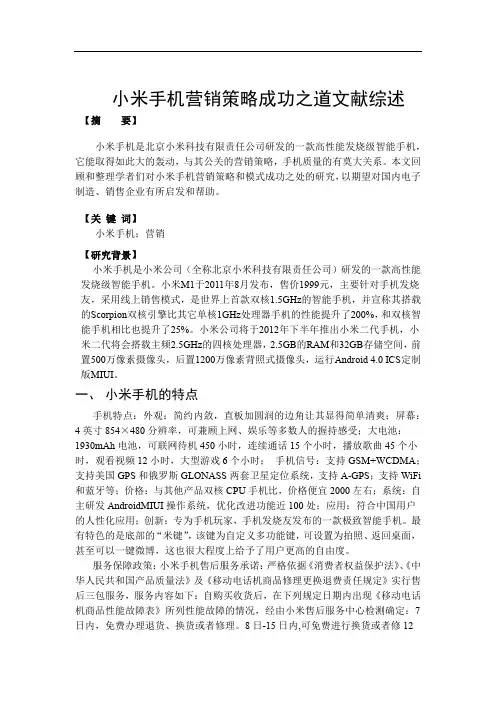
小米手机营销策略成功之道文献综述【摘要】小米手机是北京小米科技有限责任公司研发的一款高性能发烧级智能手机,它能取得如此大的轰动,与其公关的营销策略,手机质量的有莫大关系。
本文回顾和整理学者们对小米手机营销策略和模式成功之处的研究,以期望对国内电子制造、销售企业有所启发和帮助。
【关键词】小米手机;营销【研究背景】小米手机是小米公司(全称北京小米科技有限责任公司)研发的一款高性能发烧级智能手机。
小米M1于2011年8月发布,售价1999元,主要针对手机发烧友,采用线上销售模式,是世界上首款双核1.5GHz的智能手机,并宣称其搭载的Scorpion双核引擎比其它单核1GHz处理器手机的性能提升了200%,和双核智能手机相比也提升了25%。
小米公司将于2012年下半年推出小米二代手机,小米二代将会搭载主频2.5GHz的四核处理器,2.5GB的RAM和32GB存储空间,前置500万像素摄像头,后置1200万像素背照式摄像头,运行Android 4.0 ICS定制版MIUI。
一、小米手机的特点手机特点:外观:简约内敛,直板加圆润的边角让其显得简单清爽;屏幕:4英寸854×480分辨率,可兼顾上网、娱乐等多数人的握持感受;大电池:1930mAh电池,可联网待机450小时,连续通话15个小时,播放歌曲45个小时,观看视频12小时,大型游戏6个小时;手机信号:支持GSM+WCDMA;支持美国GPS和俄罗斯GLONASS两套卫星定位系统,支持A-GPS;支持WiFi 和蓝牙等;价格:与其他产品双核CPU手机比,价格便宜2000左右;系统:自主研发AndroidMIUI操作系统,优化改进功能近100处;应用:符合中国用户的人性化应用;创新:专为手机玩家,手机发烧友发布的一款极致智能手机。
最有特色的是底部的“米键”,该键为自定义多功能键,可设置为拍照、返回桌面,甚至可以一键微博,这也很大程度上给予了用户更高的自由度。
试论市场营销之电话营销论文
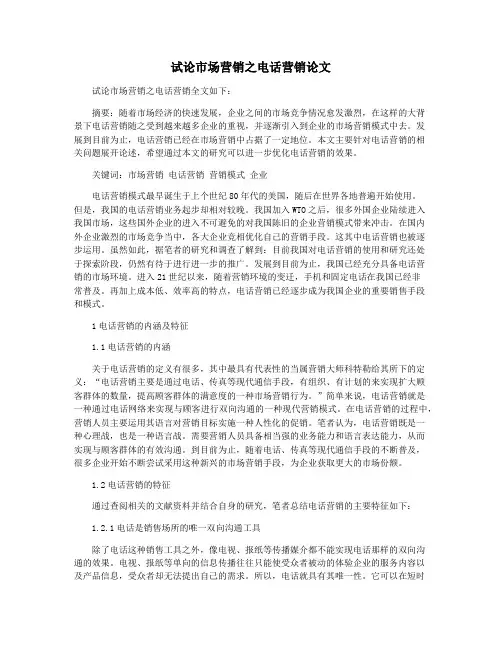
试论市场营销之电话营销论文试论市场营销之电话营销全文如下:摘要:随着市场经济的快速发展,企业之间的市场竞争情况愈发激烈,在这样的大背景下电话营销随之受到越来越多企业的重视,并逐渐引入到企业的市场营销模式中去。
发展到目前为止,电话营销已经在市场营销中占据了一定地位。
本文主要针对电话营销的相关问题展开论述,希望通过本文的研究可以进一步优化电话营销的效果。
关键词:市场营销电话营销营销模式企业电话营销模式最早诞生于上个世纪80年代的美国,随后在世界各地普遍开始使用。
但是,我国的电话营销业务起步却相对较晚。
我国加入WTO之后,很多外国企业陆续进入我国市场,这些国外企业的进入不可避免的对我国陈旧的企业营销模式带来冲击。
在国内外企业激烈的市场竞争当中,各大企业竞相优化自己的营销手段。
这其中电话营销也被逐步运用。
虽然如此,据笔者的研究和调查了解到:目前我国对电话营销的使用和研究还处于探索阶段,仍然有待于进行进一步的推广。
发展到目前为止,我国已经充分具备电话营销的市场环境。
进入21世纪以来,随着营销环境的变迁,手机和固定电话在我国已经非常普及。
再加上成本低、效率高的特点,电话营销已经逐步成为我国企业的重要销售手段和模式。
1电话营销的内涵及特征1.1电话营销的内涵关于电话营销的定义有很多,其中最具有代表性的当属营销大师科特勒给其所下的定义:“电话营销主要是通过电话、传真等现代通信手段,有组织、有计划的来实现扩大顾客群体的数量,提高顾客群体的满意度的一种市场营销行为。
”简单来说,电话营销就是一种通过电话网络来实现与顾客进行双向沟通的一种现代营销模式。
在电话营销的过程中,营销人员主要运用其语言对营销目标实施一种人性化的促销。
笔者认为,电话营销既是一种心理战,也是一种语言战。
需要营销人员具备相当强的业务能力和语言表达能力,从而实现与顾客群体的有效沟通。
到目前为止,随着电话、传真等现代通信手段的不断普及,很多企业开始不断尝试采用这种新兴的市场营销手段,为企业获取更大的市场份额。
关于电话营销的论文
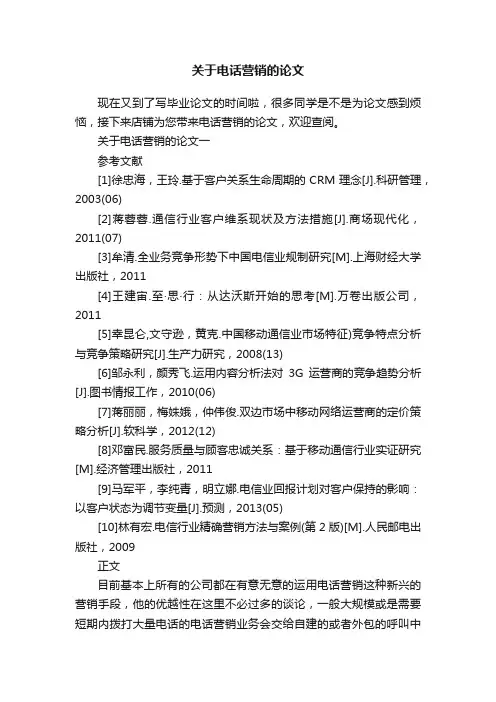
关于电话营销的论文现在又到了写毕业论文的时间啦,很多同学是不是为论文感到烦恼,接下来店铺为您带来电话营销的论文,欢迎查阅。
关于电话营销的论文一参考文献[1]徐忠海,王玲.基于客户关系生命周期的CRM理念[J].科研管理,2003(06)[2]蒋蓉蓉.通信行业客户维系现状及方法措施[J].商场现代化,2011(07)[3]牟清.全业务竞争形势下中国电信业规制研究[M].上海财经大学出版社,2011[4]王建宙.至·思·行:从达沃斯开始的思考[M].万卷出版公司,2011[5]幸昆仑,文守逊,黄克.中国移动通信业市场特征)竞争特点分析与竞争策略研究[J].生产力研究,2008(13)[6]邹永利,颜秀飞.运用内容分析法对3G运营商的竞争趋势分析[J].图书情报工作,2010(06)[7]蒋丽丽,梅姝娥,仲伟俊.双边市场中移动网络运营商的定价策略分析[J].软科学,2012(12)[8]邓富民.服务质量与顾客忠诚关系:基于移动通信行业实证研究[M].经济管理出版社,2011[9]马军平,李纯青,明立娜.电信业回报计划对客户保持的影响:以客户状态为调节变量[J].预测,2013(05)[10]林有宏.电信行业精确营销方法与案例(第2版)[M].人民邮电出版社,2009正文目前基本上所有的公司都在有意无意的运用电话营销这种新兴的营销手段,他的优越性在这里不必过多的谈论,一般大规模或是需要短期内拨打大量电话的电话营销业务会交给自建的或者外包的呼叫中心来做。
当然电话营销追求的是成功率,也不排除有告知或者推广的目的成分,在这里我们只谈论销售类型的电话营销。
影响电话销售成功率的因素是有很多方面的,下面我们逐一进行分析:第一,产品。
这里的产品指的是大产品概念,包括产品定位、质量、价格、市场空间、知名度、美誉度、认知度等。
并不是所有的产品都适合做电话销售,比如快速消费品就不适合,因为它的利润比较低,客户群广,更加适合大众营销和现场销售促进。
手机营销策略 文献综述
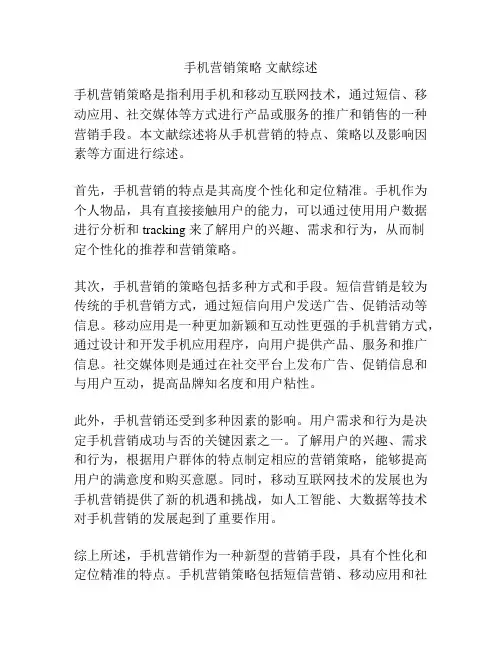
手机营销策略文献综述
手机营销策略是指利用手机和移动互联网技术,通过短信、移动应用、社交媒体等方式进行产品或服务的推广和销售的一种营销手段。
本文献综述将从手机营销的特点、策略以及影响因素等方面进行综述。
首先,手机营销的特点是其高度个性化和定位精准。
手机作为个人物品,具有直接接触用户的能力,可以通过使用用户数据进行分析和 tracking 来了解用户的兴趣、需求和行为,从而制
定个性化的推荐和营销策略。
其次,手机营销的策略包括多种方式和手段。
短信营销是较为传统的手机营销方式,通过短信向用户发送广告、促销活动等信息。
移动应用是一种更加新颖和互动性更强的手机营销方式,通过设计和开发手机应用程序,向用户提供产品、服务和推广信息。
社交媒体则是通过在社交平台上发布广告、促销信息和与用户互动,提高品牌知名度和用户粘性。
此外,手机营销还受到多种因素的影响。
用户需求和行为是决定手机营销成功与否的关键因素之一。
了解用户的兴趣、需求和行为,根据用户群体的特点制定相应的营销策略,能够提高用户的满意度和购买意愿。
同时,移动互联网技术的发展也为手机营销提供了新的机遇和挑战,如人工智能、大数据等技术对手机营销的发展起到了重要作用。
综上所述,手机营销作为一种新型的营销手段,具有个性化和定位精准的特点。
手机营销策略包括短信营销、移动应用和社
交媒体等多种方式和手段。
用户需求和行为以及移动互联网技术的发展是影响手机营销成功与否的重要因素。
未来,随着技术的不断进步,手机营销将继续发展壮大,并与其他渠道相互融合,为企业带来更多的营销机会。
电话营销技巧毕业论文范文精选
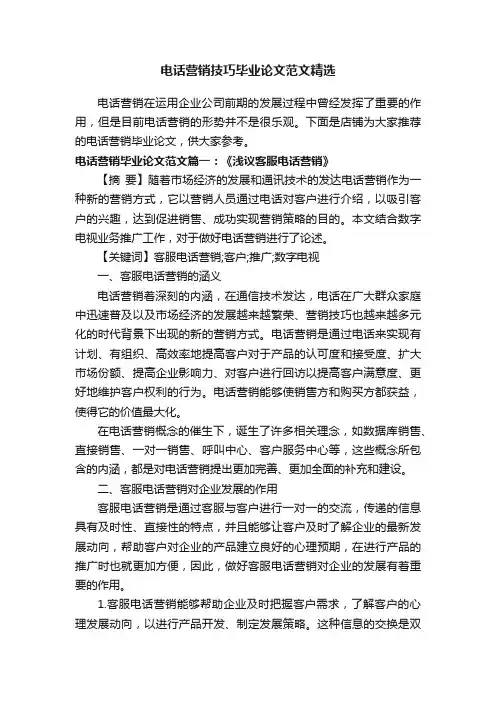
电话营销技巧毕业论文范文精选电话营销在运用企业公司前期的发展过程中曾经发挥了重要的作用,但是目前电话营销的形势并不是很乐观。
下面是店铺为大家推荐的电话营销毕业论文,供大家参考。
电话营销毕业论文范文篇一:《浅议客服电话营销》【摘要】随着市场经济的发展和通讯技术的发达电话营销作为一种新的营销方式,它以营销人员通过电话对客户进行介绍,以吸引客户的兴趣,达到促进销售、成功实现营销策略的目的。
本文结合数字电视业务推广工作,对于做好电话营销进行了论述。
【关键词】客服电话营销;客户;推广;数字电视一、客服电话营销的涵义电话营销着深刻的内涵,在通信技术发达,电话在广大群众家庭中迅速普及以及市场经济的发展越来越繁荣、营销技巧也越来越多元化的时代背景下出现的新的营销方式。
电话营销是通过电话来实现有计划、有组织、高效率地提高客户对于产品的认可度和接受度、扩大市场份额、提高企业影响力、对客户进行回访以提高客户满意度、更好地维护客户权利的行为。
电话营销能够使销售方和购买方都获益,使得它的价值最大化。
在电话营销概念的催生下,诞生了许多相关理念,如数据库销售、直接销售、一对一销售、呼叫中心、客户服务中心等,这些概念所包含的内涵,都是对电话营销提出更加完善、更加全面的补充和建设。
二、客服电话营销对企业发展的作用客服电话营销是通过客服与客户进行一对一的交流,传递的信息具有及时性、直接性的特点,并且能够让客户及时了解企业的最新发展动向,帮助客户对企业的产品建立良好的心理预期,在进行产品的推广时也就更加方便,因此,做好客服电话营销对企业的发展有着重要的作用。
1.客服电话营销能够帮助企业及时把握客户需求,了解客户的心理发展动向,以进行产品开发、制定发展策略。
这种信息的交换是双方的、互动的,客服能够通过具体的、详细的、有针对性的问题掌握客户的需要,及时地了解到客户对于企业发展、对于产品设计的意见,了解客户的最新需求,企业可根据这些信息对客户提供针对性的服务,并在综合考量的基础上为企业发展战略的制定提供更加科学的依据。
移动营销文献综述及外文文献资料
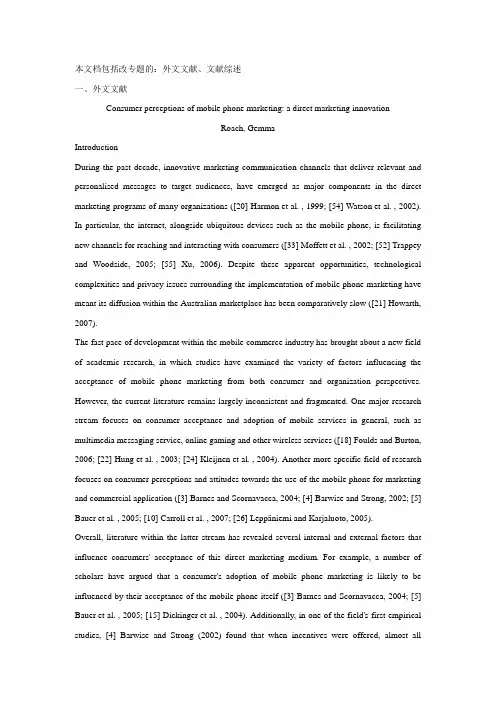
本文档包括改专题的:外文文献、文献综述一、外文文献Consumer perceptions of mobile phone marketing: a direct marketing innovationRoach, GemmaIntroductionDuring the past decade, innovative marketing communication channels that deliver relevant and personalised messages to target audiences, have emerged as major components in the direct marketing programs of many organizations ([20] Harmon et al. , 1999; [54] Watson et al. , 2002). In particular, the internet, alongside ubiquitous devices such as the mobile phone, is facilitating new channels for reaching and interacting with consumers ([33] Moffett et al. , 2002; [52] Trappey and Woodside, 2005; [55] Xu, 2006). Despite these apparent opportunities, technological complexities and privacy issues surrounding the implementation of mobile phone marketing have meant its diffusion within the Australian marketplace has been comparatively slow ([21] Howarth, 2007).The fast pace of development within the mobile commerce industry has brought about a new field of academic research, in which studies have examined the variety of factors influencing the acceptance of mobile phone marketing from both consumer and organization perspectives. However, the current literature remains largely inconsistent and fragmented. One major research stream focuses on consumer acceptance and adoption of mobile services in general, such as multimedia messaging service, online gaming and other wireless services ([18] Foulds and Burton, 2006; [22] Hung et al. , 2003; [24] Kleijnen et al. , 2004). Another more specific field of research focuses on consumer perceptions and attitudes towards the use of the mobile phone for marketing and commercial application ([3] Barnes and Scornavacca, 2004; [4] Barwise and Strong, 2002; [5] Bauer et al. , 2005; [10] Carroll et al. , 2007; [26] Leppäniemi and Karjaluoto, 2005).Overall, literature within the latter stream has revealed several internal and external factors that influence consumers' acceptance of this direct marketing medium. For example, a number of scholars have argued that a consumer's adoption of mobile phone marketing is likely to be influenced by their acceptance of the mobile phone itself ([3] Barnes and Scornavacca, 2004; [5] Bauer et al. , 2005; [15] Dickinger et al. , 2004). Additionally, in one of the field's first empirical studies, [4] Barwise and Strong (2002) found that when incentives were offered, almost allrespondents were satisfied with receiving advertisements sent to them via short message service (SMS). More recently, [32] Merisavo et al. (2007) examined the drivers of SMS advertising acceptance among Finnish consumers. Through large-scale survey research (n =4,062) they found that the usefulness and context of the message were significantly associated with consumer acceptance of advertising sent via this medium.The primary focus of this research is on three innovation attributes found by [51] Tornatzky and Klein (1982) to exert significant influence over an individual's adoption decision: relative advantage, compatibility and complexity. Relative advantage refers to the degree to which an innovation is perceived as being better than the innovation it replaces; compatibility refers to the degree that an innovation is considered compatible with the existing values, past experiences and needs of the potential adopter; and complexity refers to the level of complexity associated with understanding and using the innovation ([47] Rogers and Shoemaker, 1971). These three innovation attributes form a significant part of [46] Rogers's (1995) innovation attribute framework, which suggests that an individual's combined perception of the innovation's attributes will largely drive their adoption decision. In the past, researchers have used this, and other innovation diffusion theories to explain the adoption of technology driven innovations and for understanding consumer behavior in relation to new product development ([12] Chen et al. , 2002;[14] de Ruyter et al. , 2001; [22] Hung et al. , 2003).While [46] Rogers's (1995) innovation attribute theory offers a valid context for examining consumer adoption of mobile phone marketing, [50] Thong (1999) advises researchers combine [46] Rogers's (1995) theory with other constructs to provide a richer and potentially more explanatory model. For this reason, the proposed relationship between a consumer's level of involvement with their mobile phone (i.e. product involvement) and their adoption of mobile phone marketing will also be examined by this study.Consumers' perceptions of the three attributes listed above in the context of mobile phone marketing will form the basis for answering two principal research questions namely:RQ1. To what extent are consumer perceptions of innovation attributes associated with their adoption of mobile phone marketing?RQ2. And which, if any, innovation attribute has the greatest effect on consumer adoption of mobile phone marketing?A further research question regarding the relationship between a consumer's involvement with their mobile phone and their adoption of mobile phone marketing will also be examined:RQ3. To what extent does a consumer's involvement with their mobile phone affect their adoption of mobile phone marketing?The next section turns to consider the conceptual framework and associated hypotheses that underpin this research.2 Conceptual framework and hypothesesA review of the literature relevant to this study covered four main areas. First, the extant research in the field of mobile phone marketing was reviewed. This was followed by a consideration of the theory behind innovation adoption and the core innovation attributes. Finally, the literature relating to the concept of product involvement and how this may influence a consumer's perception of an innovation was examined.2.1 Mobile phone marketingA diverse range of definitions for the broad concept of mobile marketing exist ([35] Mort and Drennan, 2002; [44] Pousttchi and Wiedemann, 2006; [48] Salo and Tähtinen, 2005). In view of these, mobile phone marketing is defined here as the use of mobile phones to provide consumers with time and location specific, personalised information, which promotes goods, services and ideas. The novel status of the mobile phone as a one-to-one communication device suggests mobile phone marketing is reminiscent of an innovative form of direct marketing.Several researchers have studied the factors which influence consumer acceptance of marketing messages sent via this medium ([3] Barnes and Scornavacca, 2004; [4] Barwise and Strong, 2002;[5] Bauer et al. , 2005; [10] Carroll et al. , 2007; [23] Kavassalis et al. , 2003; [26] Leppäniemi and Karjaluoto, 2005). Overall, their findings reveal consistent support for three main elements: whether the user has given their permission to receive marketing messages to their mobile phone; the level of control the service provider maintains during the transaction, and extent to which the user trusts the brand being marketed.A similar stream of literature has found the characteristics of the marketing message and its delivery to be key factors driving the consumer's level of acceptability ([32] Merisavo et al. , 2007;[52] Trappey and Woodside, 2005). However, until now, there has been little research dedicated to exploring the nature of this medium, and whether this influences a consumers' decision to acceptor reject marketing communications sent directly to their mobile phone.2.2 Innovation adoptionInnovation adoption refers to "a decision to make full use of an innovation as the best course of action available" ([46] Rogers, 1995, p. 21). In studies relating to an innovation's diffusion within society, researchers have proposed a number of models that aim to predict the rate of adoption and an individual's adoption decision, according to the innovation attributes and the personal characteristics of the potential adopter.The dominant theoretical framework for analysing the relationship between an innovation's attributes and its rate of adoption is the diffusion of innovation (DOI) model developed by [46] Rogers (1995). Essentially, [46] Rogers' (1995) DOI theory suggests that when a concept is perceived as new, an individual utilises communication tactics within their social systems to arrive at a decision point of either adoption or rejection of the innovation. The innovation's attributes or characteristics serve as an important influence over the individual's adoption decision and the speed of innovation diffusion within society. In broad terms, [46] Rogers' (1995) innovation attribute framework suggests that if a potential adopter holds positive perceptions of the combined innovation attributes, then they will be more likely to adopt, or accept, the innovation. Previous researchers have suggested that [46] Rogers' (1995) DOI model is easy to use, offers mutually exclusive and exhaustive categories allowing results to be compared, and is a suitable framework for replicating and generalizing innovation adoption across studies ([8] Black et al. , 2001; [30] Mahajan et al. , 1990).In recent years, the vast majority of innovation diffusion studies have focused on the adoption of technology or tangible products. For example, a number of scholars have used [46] Rogers's (1995) framework for studying consumer adoption of innovative product technologies (see for example, [18] Foulds and Burton (2006) for multimedia messaging services; [24] Kleijnen et al. (2004) for mobile gaming; [28] Lin and Yu (2006) for the internet as a communication channel; [42] Pedersen (2005) for mobile internet services). In comparison, there are fewer studies that have concentrated on the adoption of intangible, process-like innovations, such as ideas, concepts or services. Here, the researcher has conceptualised mobile phone marketing to be a process-like innovation, which distinguishes it from the mobile phone; a product innovation.2.3 Innovation attributes[46] Rogers (1995) considers that an individual's combined perception of the five innovation attributes (relative advantage, compatibility, complexity, trialability and observability) will largely drive the individual's adoption decision. As mentioned previously, the innovation attributes applicable to mobile phone marketing in this study are: relative advantage, compatibility and complexity. The remaining two attributes; trialability and observability, refer to the degree to which an innovation can be experimented with prior to its adoption, and the degree to which the results of the innovation are visible to others ([47] Rogers and Shoemaker, 1971). These two attributes were excluded from this study because mobile phone marketing cannot be experimented with by the consumer prior to their adoption, and the results of mobile phone marketing are not directly visible to the rest of society.By definition, relative advantage refers to the degree to which an innovation is perceived as being better than the idea it supersedes ([47] Rogers and Shoemaker, 1971). In the context of mobile phone marketing, relative advantage is conceptualised as the degree to which consumers perceive this channel to be better than its alternatives, such as direct mail and email.The current innovation literature has established that relative advantage is one of the best and most consistent predictors of innovation adoption ([39] Onkvisit and Shaw, 1989; [43] Plouffe et al. , 2001; [45] Robinson, 1990; [49] Teo and Pok, 2003; [51] Tornatzky and Klein, 1982). For instance, in the context of mobile service innovations, [49] Teo and Pok (2003) found support for a relationship between consumer perceptions of relative advantage and their adoption of wireless application protocol (W AP) enabled mobile phones. Prior to this, [43] Plouffe et al. (2001) found both consumers' and merchants' perceptions of relative advantage were a key driver of their intentions to adopt a new electronic payment system. In view of these findings and the perceived advantages of receiving marketing communications via a mobile phone, it is proposed that a consumer's perception of the relative advantages associated with mobile phone marketing will be positively related to their adoption decision:H1. Relative advantage is positively and significantly related to consumer adoption of mobile phone marketing.The second innovation attribute to be examined in this study is compatibility, which describes the degree to which to an innovation is perceived as compatible with the existing values, past experiences and needs of potential adopters ([47] Rogers and Shoemaker, 1971). In terms ofmobile phone marketing, this construct may simply denote a consumer's familiarity, or level of comfort with this type of direct marketing. Prior research has established a clear and consistent relationship between compatibility and the adoption of technology driven innovations ([1] Agarwal and Prasad, 1997; [8] Black et al. , 2001). Outside of this, user permission and their control of communication have also been found to be key drivers of consumer acceptance of mobile phone advertising ([3] Barnes and Scornavacca, 2004; [4] Barwise and Strong, 2002). Within this study, the personal nature of the mobile phone suggests that the degree of compatibility between a consumer's own values, and that which they perceive to be associated with mobile phone marketing, will be positively related to their adoption decision:H2. Compatibility is positively and significantly related to consumer adoption of mobile phone marketing.The final innovation attribute to be incorporated into this study is complexity, which refers to "the degree to which an innovation is perceived as relatively difficult to understand and use" ([47] Rogers and Shoemaker, 1971, p. 154) and is considered by many to be a close substitute to the "perceived ease of use" factor acknowledged in [13] Davis's (1989) technology acceptance model. Several studies have established a clear association between complexity and innovation adoption ([24] Kleijnen et al. , 2004; [40] Pagani, 2004; [49] Teo and Pok, 2003). Given the perceived intricacies associated with mobile phone technology, it is proposed that consumer perceptions of complexity will be negatively associated with their adoption of mobile phone marketing:H3. Complexity is negatively and significantly related to consumer adoption of mobile phone marketing.2.4 Product involvementThe concept of product involvement has received widespread attention in the marketing realm since the 1980s, particularly in relation to advertising and consumer behavior ([2] Andrews et al. , 1990; [37] Neal et al. , 2004). Product involvement refers to the way in which consumers view different product categories, with regards to their feelings, thoughts and behavioral responses ([19] Gordon et al. , 1998). In the field of consumer behavior, previous researchers have found that a consumer's level of product involvement can influence their behavior through its affect on information search and processing ([2] Andrews et al. , 1990; [9] Bloch et al. , 1986; [31] Mantel and Kardes, 1999).Of particular relevance is a study by [6] Bauer et al. (2006), who found strong support for the relationship between consumer decision-making styles and product involvement across a number of product categories. In particular, they described three main factors influencing the consumer's level of product involvement: importance; pleasure and sign value. From a somewhat different perspective, [16] Drossos et al. (2007) stated that a consumer's attitude towards SMS advertising differed according to whether the product being advertised was a high or low involvement product.Within this research setting, it is surmised that mobile phones are an effective and efficient channel for companies to communicate product and promotional information to consumers, thus influencing their adoption decision. Accordingly, consumers who place considerable importance and sign value on their mobile phone (for example, enjoy having the latest model) are more likely to perceive mobile phone marketing to be compatible with their lifestyle and preferences. Thus, it is proposed that a consumer's level of involvement with their mobile phone will influence their decision to adopt or reject marketing communications sent via this channel:H4. Product involvement is positively and significantly related to consumer adoption of mobile phone marketing.3 Research methodologyIn addressing the aforementioned research questions and hypotheses, a deductive, quantitative methodological approach was adopted. Data were collected from a non-random sample of undergraduate university students at an Australian institution. Undergraduate students were chosen primarily for their accessibility, but additionally because they represent a key target market for mobile phone marketing due to the majority having grown up in the technological age. A self-administered questionnaire was developed, and then pretested with a separate group of respondents to enhance its overall design. Results of the pretest revealed minor instances of ambiguous wording (which were subsequently changed) and confirmed the expected completion time for the questionnaire. To ensure a common frame of reference, the opening section of the questionnaire contained a definition and brief explanation of mobile phone marketing. A total of 271 questionnaires were distributed in August 2007, of which 254 were returned and deemed valid for data analysis, representing a response rate of 93.7 per cent. [7] Bernard (2000) suggests that a valid response rate for face-to-face surveys, as were used here, is approximately 80 per cent.Each of the independent variables and the dependent variable were measured in subsequent sections of the questionnaire. Demographic data were also collected, to allow the researcher to obtain a deeper understanding of the participants' responses. As shown in Table I [Figure omitted. See Article Image.], the majority of respondents were aged 20 years and under (44.1 per cent) with an additional 41.3 per cent aged between 21 and 25 years old. More than 75 per cent earned an annual gross income of $20,000 or less, which was expected given the undergraduate student status of the sample.The innovation attributes of relative advantage and complexity were measured using multi-item index scales, which were modified versions of those used in other empirical studies of technology driven innovations ([13] Davis, 1989; [32] Merisavo et al. , 2007; [34] Moore and Benbasat, 1991;[41] Pavlou, 2003). Compatibility, the third innovation attribute, was also measured with a multi-item scale. However, in this instance, the scale was originally developed by the researcher to suit the unique requirements of the current research setting. Although the researcher examined several measurement scales for this construct, many of the already established items could not be suitably modified to measure an individual's compatibility with an intangible, service-like innovation such is mobile phone marketing.A consumer's level of involvement with their mobile phone (i.e. product involvement) was measured using a modified version of the multi-item index used by [6] Bauer et al. (2006), which reflected the importance, pleasure, and sign value a consumer places on a particular product. Finally, the dependent variable, consumer adoption of mobile phone marketing, was measured by three items reflecting the consumer's perception of, and commitment to, mobile phone marketing. In all cases, a seven-point Likert scale was used, where 1="strongly disagree" and 7="strongly agree".Prior to performing correlation and regression analysis on the data, all five measurement scales were subject to exploratory principal components factor analysis with varimax rotation. [17] Field (2005) suggests that this is an appropriate method for checking the validity of questionnaire items. The results of the factor analysis revealed that all three items used to measure consumer adoption of mobile phone marketing loaded substantially (>0.40) on the extracted factor. In addition, all but three of the 15 items used to measure the innovation attributes loaded substantially on their respective factors. Thus, nearly all of the dimensions initially proposed by the researcher wererepresented.An exploratory principal components factor analysis was also performed on the five items used to measure the participants' involvement with their mobile phone. This analysis generated one principal component with an eigenvalue of 2.25, explaining 44.94 per cent of variance in this factor. All five product involvement items had substantial loadings on the extracted factor, and thus the validity of the initial scale was established.Following factor analysis, the data were checked for reliability using Cronbach's α coefficient. As shown in Table II [Figure omitted. See Article Image.], the results of this test revealed that each of the scales used to measure the independent variables and the dependent variable, presented acceptable levels of reliability (that is, above the minimum level of 0.60 as suggested by [38] Nunnally, 1967).4 Research findingsAll four hypotheses were first tested using a series of simple correlation analyses. Upon inspection of the correlation matrix for the innovation attributes and consumer adoption of mobile phone marketing (Table III [Figure omitted. See Article Image.]), it was revealed that relative advantage had a significant and positive correlation with a consumer's decision to adopt mobile phone marketing ( r=0.75, p <0.01). Thus, H1 is supported. Compatibility also had a significant and positive correlation with the dependent variable (r=0.78, p <0.01), thus supporting H2 . However, despite its significance, the direction of the relationship between complexity and adoption was positive (r =0.20, p <0.01), thus offering no support for H3 .Among the independent variables, relative advantage and compatibility also exhibited very strong correlations with each other, and thus the threat of multicollinearity existed. For this reason, the variance inflation factors associated with each variable were examined, both of which were well below the ten point cut-off recommended by [36] Myers (1990) and hence, the threat was refuted. The correlation matrix (Table III [Figure omitted. See Article Image.]) was also examined for the purpose of confirming the order in which the innovation attributes would be regressed against the dependent variable.The next stage of data analysis involved multiple hierarchical regression of the innovation attributes and the dependent variable, consumer adoption of mobile phone marketing. This type of analysis was performed to determine the strength and direction of the relationships between allfour variables (when all were accounted for). In doing so, the researcher was able to further analyse H1 , H2and H3 . The results of the multiple regression analysis are reported in Table IV [Figure omitted. See Article Image.].At the final stage of the regression model, only relative advantage and compatibility were identified as significant predictors of consumer adoption of mobile phone marketing, thereby offering further support for H1 and H2 . Interestingly, the variables relative advantage and compatibility also produced relatively strong and significant coefficients at stages 2 and 3 of the regression model, which suggests that the greatest proportion of variance in consumers' adoption of mobile phone marketing can be explained when both these variables are accounted for. However, to determine which of these attributes has the greatest affect on a consumer's adoption decision, the standardised regression coefficients for relative advantage and compatibility were examined simultaneously. As shown in stage 3 of the regression model, when compared with relative advantage ( ß =0.388), compatibility (ß =0.502) produced a slightly larger standardised regression coefficient. Therefore, the degree of compatibility a consumer perceives to exist between their own values and those associated with mobile phone marketing, has the greatest affect on their decision to adopt or reject marketing communication sent via this medium.The results of the multiple regression analysis for the innovation attributes and the dependent variable appear to largely confirm previous research findings. Namely, the influence of compatibility on the adoption decision is not overly surprising given that user permission, privacy, service provider control and brand trust are all key factors that have previously been found to drive consumer acceptance of mobile phone marketing ([3] Barnes and Scornavacca, 2004; [4] Barwise and Strong, 2002; [5] Bauer et al. , 2005; [10] Carroll et al. , 2007).However, the lack of support for the impact of complexity on the adoption decision contests the findings established by past technology innovation literature ([24] Kleijnen et al. , 2004; [49] Teo and Pok, 2003). Possible explanations for this lie in the nature of the innovation examined here and the age structure of the sample used. In general, the actions involved in responding to a mobile phone marketing message do not differ from those required to perform day-to-day functions such as making a phone call or sending a text message. Thus, consumers are not required to develop new skills in order to adopt this innovation, a fact which is likely to reduce the influence of this attribute on the adoption decision ([46] Rogers, 1995). Furthermore, younger consumers are morelikely to be proficient users of mobile phone technology ([29] Ling and Yttri, 2002), having been surrounded by such telecommunication devices since a relatively young age. This being the case, any complexities associated with mobile phone marketing are likely to be less of a concern to this age group than the level of compatibility this marketing channel presents.To test the hypothesized relationship between a consumer's involvement with their mobile phone and their adoption of mobile phone marketing, a correlation matrix of these two variables was produced and examined. This revealed that although there is only a weak level of association between product involvement and adoption ( r =0.25, p <0.01) the relationship is positive, and therefore H4 is supported.However, to examine this relationship further, simple linear regression was performed on the consumer involvement and adoption variables (see Table V [Figure omitted. See Article Image.] for the results of this analysis). Overall, the regression model accounted for 63 per cent of the variance in the prediction of a consumer's adoption mobile phone marketing, F (1, 252)=17.04, p <0.001. Further inspection of the regression coefficients revealed that consumer involvement is a statistically significant predictor of mobile phone marketing adoption, ß =0.252, t (252)=4.13, p <0.001. Therefore, the more a consumer is involved with their mobile phone, the more likely they will adopt (or accept) marketing communications sent via this medium.This finding is consistent with the themes outlined in the literature review, in particular the relationship between product involvement and consumer behavior ([11] Celsi and Olson, 1988;[25] Lee and Miller, 2006; [53] Warrington and Shim, 2000). In addition, the findings here have confirmed that a consumer, who places a high level of importance and sign value on their mobile phone, is more likely to accept this innovation as a direct marketing channel. A likely explanation for this derives from the ability of marketers to provide consumers with, or for consumers to request, up-to-date product information via their mobile phone. In this sense, it was surmised that the mobile phone offers consumers a valuable tool for conducting efficient and effective information search as part of their overall purchase decision.Yet despite this, the low mean score for product involvement (3.63 out of 7) found here implies that predominantly the consumers surveyed had little or no involvement with their mobile phone (a result that was somewhat surprising given the predominantly young age of the sample). As such,。
电话营销策略探讨论文
电话营销策略探讨论文电话营销策略探讨论文电话营销的兴起是从20世纪60年代末期开始的,营销者为了维护企业的经济规模,因而增添了一种新的直销模式。
电话营销这种新兴的营销方式具有其自身的优势,在企业营销当中占有重要的位置,但是由于其实施的时间尚短,还有很多不足和缺陷,需要对其进行改进,将其更好的完善。
电话营销策略探讨论文篇一《电话营销策略探讨》[摘要]泰康人寿保险公司的电话营销模式发展较早,但是泰康人寿保险公司的电话营销模式还存在一定的缺陷。
本文对其电话营销模式进行了分析,并提出了改善方案,希望可以提高泰康人寿保险公司的市场竞争力,使企业全面迅速的发展。
[关键词]泰康人寿;电话营销;策略我国的寿险业还没有发展成熟,处于弱势时期,而国外的寿险行业已经发展完善,具有先进的技术水平,管理经验十分丰富。
所以这些因素的存在,对于中国的保险公司而言,形势是十分严峻的。
在我国的商业保险领域之中,泰康人寿保险、中国平安保险、中国人寿保险、太平洋保险、新华人寿保险等公司属于早期成立的一批公司,相对来说规模比较大,属于保险行业内部的“第一军团”。
虽然这几家公司占领着业内80%以上的市场份额,但是在面临这些挑战的时候,如何守住国内的市场,优化公司结构和营销策略,使经营风险有所降低,巩固以及提高市场竞争能力,都是要解决的问题。
1电话营销的市场背景及发展电话营销的兴起是从20世纪60年代末期开始的,营销者为了维护企业的经济规模,因而增添了一种新的直销模式。
这在市场营销学里面属于“无店铺销售”的范畴,70年代时,电话营销开始被广泛使用,欧美等一些经济发达国家对其尤为重视,将之视为商业社会活动中所必要的技术和专业知识。
发展到现在,电话营销已经成为了一种主要的直销方式。
我国的电话营销是从90年代开始发展的。
电话营销的销售成本很低、营销速度很快、覆盖的面积十分的广泛,并且还具有相当良好的互动性,因此它逐渐地成为一种十分有力的,并且是不能够被取代的营销模式,一直到今天,电话营销仍旧被视为十分重要的营销模式之一。
有关电话营销论文范文
有关电话营销论文范文为了获得更多的客户资料,企业也是花费了不少功夫,为了不让这些功夫失效,企业必须好好利用这些客户资源,向客户介绍本单位的产品,故形成电话营销。
这也是一种新型的营销方式。
电话营销向网络营销发展的必然性随着科学技术的发展、网民数量的激增,网络在人们的日常生活中扮演着越来越重要的角色;同时,网络营销推广也凭借其诸多优点正在逐渐成为最重要、最有效的营销推广方式。
随着网络影响的进一步扩大,随着人们对于网络营销理解的进一步加深,以及越来越多出现的网络营销推广的成功案例,人们已经开始意识到网络营销的诸多优点并越来越多的通过网络进行营销推广。
1.从流程角度进行分析。
1.1网络营销的流程:第一步是将自己的企业全面快速地搬到互联网。
企业在建立自己的网络营销方案的时候,首先要考虑到自己的网站属于营销型的网站。
第二步是通过多种网络营销工具和方法来推广和维护自己的企业网站。
我们在互联网做的任何宣传和推广活动都必须以企业的网站为核心。
第三步是网站流量监控与管理。
通常我们采用流量监控与分析系统和在线客服系统来实现。
营销型网站需要一套功能齐聚的在线客服系统,以此来帮助我们时时主动将发出洽谈,能够及时将有效的流量潜在客户或意向客户转换为网上销售。
1.2电话营销的流程。
电话营销最关键的一步就是准确找到需要产品或服务的人,然后有目的、有针对性地与目标客户进行沟通,具体流程如下。
第一步是事先选定目标客户的行业,通过网页、网络筛选客户,准备一份可以供一个月使用的人员名单,第二步是寻找最有效的电话营销时间。
通常来说,人们拨打销售电话的时间是在早上9点到下午5点之间。
一般安排在上午8:00~9:00,中午12:00~13:00和17:00~18:30之间营销。
第三步是电话营销拜访。
电话做销售持续大约3分钟,以便给出一个很好的理由让对方愿意花费宝贵的时间和你交谈。
2.从优缺点角度进行分析。
2.1电话营销的缺点。
第一,花费成本较高。
简述电话销售毕业设计参考文献[Word文档]
简述电话销售毕业设计参考文献本文档格式为WORD,感谢你的阅读。
最新最全的学术论文期刊文献年终总结年终报告工作总结个人总结述职报告实习报告单位总结演讲稿简述电话销售毕业设计参考文献论文最好能建立在平日比较注意探索的问题的基础上,写论文主要是反映学生对问题的思考,详细内容请看下文电话销售毕业设计。
参考文献一:[1]张传福,刘丽丽,卢辉娬,郎逊雪.移动互联网技术及业务[M].第1版.电子工业出版社.2012.3-8.[2]缪敬.移动互联网对智能手机的影响[J].中兴通讯技术.2009(8).[3]陈亮途.社会化营销:人人参与的营销力量[M].沈阳:万卷出版公司.2011.[4]冯琪.我国国产手机市场研究[D].天津大学.2009.[5]吴泅宗.市场营销学[M].北京:清华大学出版社.2008.7-13.[6]苏彬.如何全面提升企业核心竞争力[J].中国商界:上半月.2012(4).215-215.[7]CNNIC.中国互联网络发展状况统计报告[R].2014(7).[8]李东进.消费者行为学[M].北京:机械工业出版社.2007.20-25[9]李亚婷.小米制造之谜[J]?中国经济和信息化.2014(8).29-39.[10]秦蓁,张立.移动互联网时代的终端产业发展趋势[;F].数据通信.邮电设计技术.2010(9).51-54.[11]菲利普.科特勒,凯文.凯恩.凯勒,卢泰宏?营销管理[M].第13版.中国人民大学出版社.2009.203-221.[12]孙宁,章爱民着.国际营销学[M].北京.高等教育出版社.2011.3-6参考文献二:[1]徐忠海,王玲.基于客户关系生命周期的CRM理念[J].科研管理,2003(06)[2]蒋蓉蓉.通信行业客户维系现状及方法措施[J].商场现代化,2011(07)[3]牟清.全业务竞争形势下中国电信业规制研究[M].上海财经大学出版社,2011[4]王建宙.至·思·行:从达沃斯开始的思考[M].万卷出版公司,2011[5]幸昆仑,文守逊,黄克.中国移动通信业市场特征)竞争特点分析与竞争策略研究[J].生产力研究,2008(13)[6]邹永利,颜秀飞.运用内容分析法对3G运营商的竞争趋势分析[J].图书情报工作,2010(06)[7]蒋丽丽,梅姝娥,仲伟俊.双边市场中移动网络运营商的定价策略分析[J].软科学,2012(12)[8]邓富民.服务质量与顾客忠诚关系:基于移动通信行业实证研究[M].经济管理出版社,2011[9]马军平,李纯青,明立娜.电信业回报计划对客户保持的影响:以客户状态为调节变量[J].预测,2013(05)[10]林有宏.电信行业精确营销方法与案例(第2版)[M].人民邮电出版社,2009参考文献三:[1]增值业务的发展困境2007-10-29[2]刘卫明.电话营销在项目投资中的应用.黄冈师范学院学报,2006,(26):80-81[3]张磊.电话营销让沟通为企业创造更大的价值.四川通信报,2003-06-04[4]张可成,王孝莹.电话营销在企业中的应用.泰山乡镇企业大学学报,2000,(4):22-23[5]宋俊德.我国CTI技术的发展和未来.中国计算机用户,2003,(6):22-23[6]王建欣.基于CTI技术的电话自动订票与语音信箱系统的设计与实现:[大连理工大学学位论文].大连:大连理工大学,2003[7]张晓强.呼叫中心简介及解决方案.信息技术,2002,(11)[8]张晨昊,吴桂清.基于CTI技术的中小企业呼叫中心的设计与实现:[湖南大学学位论文].长沙:湖南大学,2007[9]陈坚,徐达.中国移动通信集团通信培训教材.北京:中国移动通信集团人力资源部,2002,95-147[10]张磊.电话营销让沟通为企业创造更大的价值.四川通信报,2003-06-04[11]张可成,王孝莹.电话营销在企业中的应用.泰山乡镇企业大学学报,2000,(4):22-23参考文献四:[1].刘子安,中国市场营销,对外经济贸易大学出版社,2006年3月第一版,p105-p125。
电话内容营销总结范文
电话内容营销总结范文随着现代经济的发展和商业竞争的激烈,各种营销手段层出不穷。
而电话内容营销作为其中的一种重要手段,受到了越来越多企业的青睐。
电话内容营销是指通过电话进行推销、宣传和维护顾客关系的活动。
本文将从电话内容营销的定义、目的、方法以及优缺点等方面进行总结和探讨。
首先,电话内容营销是指企业通过电话向潜在客户和已有客户推销、宣传产品或服务,以达到销售和服务的目的的一种营销活动。
电话内容营销具有直接、实时的特点,能够快速地和客户进行沟通,及时地传递信息,有效地推动销售。
电话内容营销通常涉及到销售推广、市场调研、客户维护等多个方面。
电话内容营销的主要目的是增加销售额、提升品牌影响力、维护客户关系。
通过电话内容营销,企业可以直接将产品或服务的信息传递给潜在客户,引导他们进行购买决策;对于已有客户,可以通过电话提供更好的售后服务,增强客户满意度和忠诚度。
此外,电话内容营销还可以实时了解客户需求和反馈,帮助企业优化产品、改善服务。
电话内容营销的方法主要包括推销呼叫、市场调研和客户关怀。
推销呼叫是指通过电话向潜在客户推销产品或服务。
在进行推销呼叫时,需要根据客户特点和需求制定相应的推销策略,并善于利用语言表达技巧和沟通技巧,与客户进行有效的交流。
市场调研是指通过电话对潜在客户进行问卷调查、市场调研等活动,以了解市场需求和竞争情况。
客户关怀是指通过电话向已有客户提供售后服务、回访等活动,维护良好的客户关系。
然而,电话内容营销也存在一些不足之处。
首先,电话内容营销容易被客户视为骚扰,有可能导致客户对企业产生反感。
其次,电话内容营销需要大量投入人力和时间,对企业的运营成本有一定的压力。
再次,电话内容营销需要专业的人员进行操作,对人员素质要求较高,如沟通能力、销售技巧等。
因此,企业在进行电话内容营销前,需要制定合理的策略和规范,充分考虑客户的需求和接受程度。
综上所述,电话内容营销作为一种重要的营销手段,在现代商业活动中发挥着重要的作用。
- 1、下载文档前请自行甄别文档内容的完整性,平台不提供额外的编辑、内容补充、找答案等附加服务。
- 2、"仅部分预览"的文档,不可在线预览部分如存在完整性等问题,可反馈申请退款(可完整预览的文档不适用该条件!)。
- 3、如文档侵犯您的权益,请联系客服反馈,我们会尽快为您处理(人工客服工作时间:9:00-18:30)。
关于电话营销模式的文献综述一﹑前言网络招聘正成为互联网上最成功的商业应用之一。
在国内市场上来看,经历了近10年的市场培育和近两三年来的快速成长,网络招聘已经代替传统招聘成为最主流的求职方式。
由于网络招聘行业进入门槛低,成本低廉,利润可观,新的人才网不断消现,而同行业公司的规模也在逐步扩张,截至2006年年底,我国人才网站数量已经突破2000家,页面点击率达40亿人次以上。
而伴随随着Web2.0和垂直搜索网站的相继进入,一线招聘网站的上市融资加速,网络招聘市场的争夺也异常激烈起来,尤其是在中高端市场,一场大战已不可避免。
在市场激烈竞争的今天,由于城市规模扩大、交通阻塞等原因,登门拜访式的营销效率越来越低,而成本却不断上升。
作为直复营销的一种方式,一种营销手段,电话营销能使企业在一定的时间内,快速地将信息传递给目标客户,及时抢占目标市场。
在激烈的网络招聘市场竞争中,电话营销作为一种能够帮助网络企业获取更多客户的营销模式,正在越来越多地为众多企业所采用。
二、国外研究现状时昆和周仁在《电话营销在我国咨询业的发展现状及对策研究》中写道:电话营销很早就在美国得以发展,近代逐渐发展到日本、台湾、印度、新加坡等亚洲地区。
真正的电话营销诞生于美国20世纪60年代的免费电话的开通。
此时只是消费者通过免费电话询问有关产品或服务的信息并决定是否购买。
近代逐渐发展到日本、台湾、印度、新加坡等亚洲地区。
在70年代,电话已经被广泛使用,在欧美一些经济发达的国家,并且已经成为商业社会中必须掌握的一门技术和专业知识。
现在已经形成一套完整的商业科学。
过去20年,电话营销在美国得到长足发展,已经形成了一个产业。
商家认为这一手段可以有效提高到达顾客的机率,并可以同顾客互动接触。
目前关于电话营销的定义有很多,海内外的不同的定义反映了人们对电话营销这一销售模式理解的倾向性,也反映了对电话营销重要性认识的深化。
在美国,电话营销通常指“商品、服务概念诞生,市场调查/分析,实际开发,商品化,广告宣传,销售,客户调查/分析,再开发”这一闭环。
它的对象概括起来有两大类:一般消费者(B-C,Business To Consumer)和企业(B-B,Business To Business)。
其中面向一般消费者的呼入业务包括:商品或服务的订购受理,旅馆、机票预约以及包含投拆处理的客户服务。
呼出业务包括:商品或服务的推销、市场调查、市场测试等。
面向企业的呼入业务主要是商品或服务的订购受理及客户服务,呼出业务主要是推销、销售支持等。
在国内则认为电话营销是通过使用电话、传真等通信技术,来实现有计划、有组织、并且高效率地扩大顾客群、提高顾客满意度、维护顾客等市场行为的手法。
成功的电话营销应该使电话双方都能体会到电话营销的价值。
电话营销可以被运用于多钟营销活动。
在市场规模上,海外各国也发展不同。
刘明在《电话营销——多媒体时代的秘密武器》中指出:美国是世界上电话营销最为盛行的地方。
现拥有15,000个呼叫中心,并仍以31%的年速度增长。
1997年直销相关产业的雇用人员为2,289万人,其中833万为电话营销的相关人员。
预测2002年可增至1,086万人。
根据美国直销协会(DMA-Diret Markting Association)提供的数据,1997年全美直销所创造的营业额为12,262亿美元。
其中电话营销所占的比例为34.6%,4,245亿美元。
迄今为止,欧洲由于语音、国度的限制,电话营销的推广比美国要慢。
但随着欧盟的建立,面对拥有上亿人的巨大市场,可预见其今后电话营销将有显著成长。
据Datamonitor公司提供的资料,1998年欧洲13国拥有9,700个呼叫中心,预计在2002年将增至1万至8千5百个。
到2000年直销所产生的营业额将达到330亿美元,其中20%通过电话营销所产生。
表1中还提供了欧洲现有呼叫中心的使用状况,其中客户服务为51%,电话销售为26%。
日本的电话营销是最近几年才发展起来的的,但是发展势头非常强劲。
1998年仅呼叫中心系统集成的费用就高达1,113亿4000万日元。
据日本有关通信协会提供的数据1997年度日本通信方面的总营业额为22,000亿日元,其中47%,10494亿日元是通过电话来实现的。
姚能笔在《电话营销的新机会》中指出:电话营销在一些先进国家(例如美国、英国、澳洲等地)发展了几十年,从消费端来看,有相当比例的人已经习惯接受这种营销方式;而以营销端来说,由于电话营销可以充分发挥大数法则,具有极高的营销效益与成本效率,对企业而言,是一种不可被取代的营销模式,这只会持续成长而不会衰退或消失。
三、国内研究现状随着当今商战日趋激烈,商品生产日趋饱和,各种促销手段效果不断下降,于是有了如绿色营销,网络营销,定制营销等各具特色的营销方式也纷纷出现,而目前,直复营销已经风靡整个世界,掀起了一场营销革命。
于是,电话营销的引进和推广便成了大势所趋。
市场营销模式决定着市场营销效率,而电话营销作为近年来国际流行的营销模式被世界各国企业广泛应用。
由于过去我国电话普及率低,营销创新意识差等原因,我国企业对电话营销的认识还不够深入,电话营销为企业带来的经济效益还不够大,但外国企业已经把电话营销作为最主要的营销模式在应用。
我国企业只有在全国、深入了解电话营销的基础上才能用好、用活电话营销模式。
彭芳在《打造电话营销市场》中指出:对于电话营销的发展,不同厂商有不同的理解,但都有一个共同点;从建设阶段到如何更好地利用它为企业服务。
结合公司的专注点———呼出与呼入一体化平台。
中国电话营销的呼叫中心在呼入这一块基本已经饱和,但在呼出方面,市场才刚刚开始,也就是说,电话营销才刚刚起步。
在彭芳看来,从功能和应用角度可以把呼叫中心划分成三个阶段。
第一阶段,以呼入为主的呼叫中心。
建立语音为主的呼入平台,由客户服务部负责,以提高公司的服务水准为目的,提供信息服务。
第二阶段,以呼出为主的呼叫中心。
主要是建立新型的电话营销平台,不仅提供信息服务,还可以作为电子商务的一部分形成交易。
由营销部门负责,通过这个平台可以主动与客户联系,推销公司的产品和服务,为公司提供新的利润增长点。
目前我国已有少数使用中。
第三阶段,综合呼叫中心。
在这个阶段,系统承担着客户服务中心和电话营销中心的责任,把销售蕴涵在客户服务中。
两者的融合降低了成本,真正使得呼叫中心从单纯的成本中心转化为利润中心。
其模式是将呼入坐席与呼出坐席合并,缩减整体坐席投入,最终达到语音和多媒体融合,呼入和呼出融合。
张磊在《电话营销让沟通为企业创造更大价值》中指出:在信息时代,电话营销给企业带来的益处是显而易见的。
其一,企业可以及时把握客户的需求。
通过双方沟通,企业可及时了解消费者的需求、意见,从而提供针对性的服务,并为今后的业务发展提供参考。
其二,电话营销可以扩大企业营业额。
电话营销是一种交互式的沟通,在接打客户电话时,可以对客户的购买习惯进行调查。
这样,不仅仅可以满足客户的订单要求,同时也可以进行交叉销售和增值销售,推销更高价位的产品,从而创造更大的经济效益。
其三,能有效维持企业与客户的关系。
通过电话的定期联系,对有发展潜力的客户进行追踪服务从而最终使其转化为我们的客户。
电话营销还可以对客户的抱怨给予答复,消除客户的顾虑最终接受我们的产品。
这些工作,在人力、成本方面是上门访问所无法比拟的。
另外,这样的联系可以密切企业和消费者的关系,增强客户对企业的忠诚度,让客户更加喜爱我们的产品。
薛建新在《企业运用电话营销手段要避免步美国后尘》中指出:如果要避免步美国的后尘,必须要注意几点:首先,必须要有高质量的数据库,要有更多的关于机主的信息,而且必须不断更新,防止老化,“仅仅知道一个号码,是不足以支撑电话营销的”;其次,提高电话营销操作人员的素质,减少给顾客带来的反感,同时在尽可能短的时间里把产品或意图介绍清楚;第三,营造良性竞争环境,防止过度开发利用电话资源。
其实,企业应该了解到“电话营销是有局限的,要更多地利用营销组合的力量,而不仅仅是某一种营销方式”。
王春艳在《呼叫中心岗位轮换谨防人员流失》中指出:人才是企业的竞争资源,对呼叫中心更是如此。
由于座席人员的工作相对流程化、单一枯燥、薪酬待遇不高等,使座席人员成为呼叫中心领域从业者中流失率偏高的人群,这也是困扰很多呼叫中心管理者的一个难题。
在执行座席人员岗位轮换过程中,需要注意的几个问题。
1、评估现有座席人员的素质;2、与目标人员进行交流沟通;3、培训业务知识及销售技能;4、建立具有竞争力的薪酬体系;5、密切关注,及时调整。
四、总结本文参考了20篇的国内外的文献对电话营销的概念、电话营销的内涵,目前电话营销实施过程中存在的问题,电话营销的技巧,电话营销的策划与管理,电话营销售后服务、电话营销人员的管理等到方面对电话营销模式进行了研究。
从总体上来说我国对电话营销的研究基本上不处于对西方先进理论的消化吸收阶段。
时昆和周仁的《电话营销在我国咨询业的发展现状及对策研究》,丁昶和蒋胜的《电话营销比较优势及创新发展对策》,刘维的《将电话营销发挥到极致》等著作都把我国的电话营销模式的研究推上了一个台阶。
既然电话营销涉及到各个方面,因此对品牌运营策略的系统研究是很有必要。
但国内很少有这样的研究,即使有也是针对某一行业的,针对某一企业的真的是少之又少,因此论文针对性一间企业的电话营销模式来研究是具有现实意义的。
参考文献[1]丁昶蒋胜电话营销比较优势及创新发展对策[J].保险研究,2006[2]时昆周仁电话营销在我国咨询业的发展现状及对策研究[J].理论广角,2007[3]林思明卓博培训教材[M].卓博人才网,2006[4]高心共雷美茂论电话营销在我国的运用[D].福建商业高等专科学校,1999[5]吕庆华谈电话直效营销的策划与管理[D].福建师范大学,2001。
